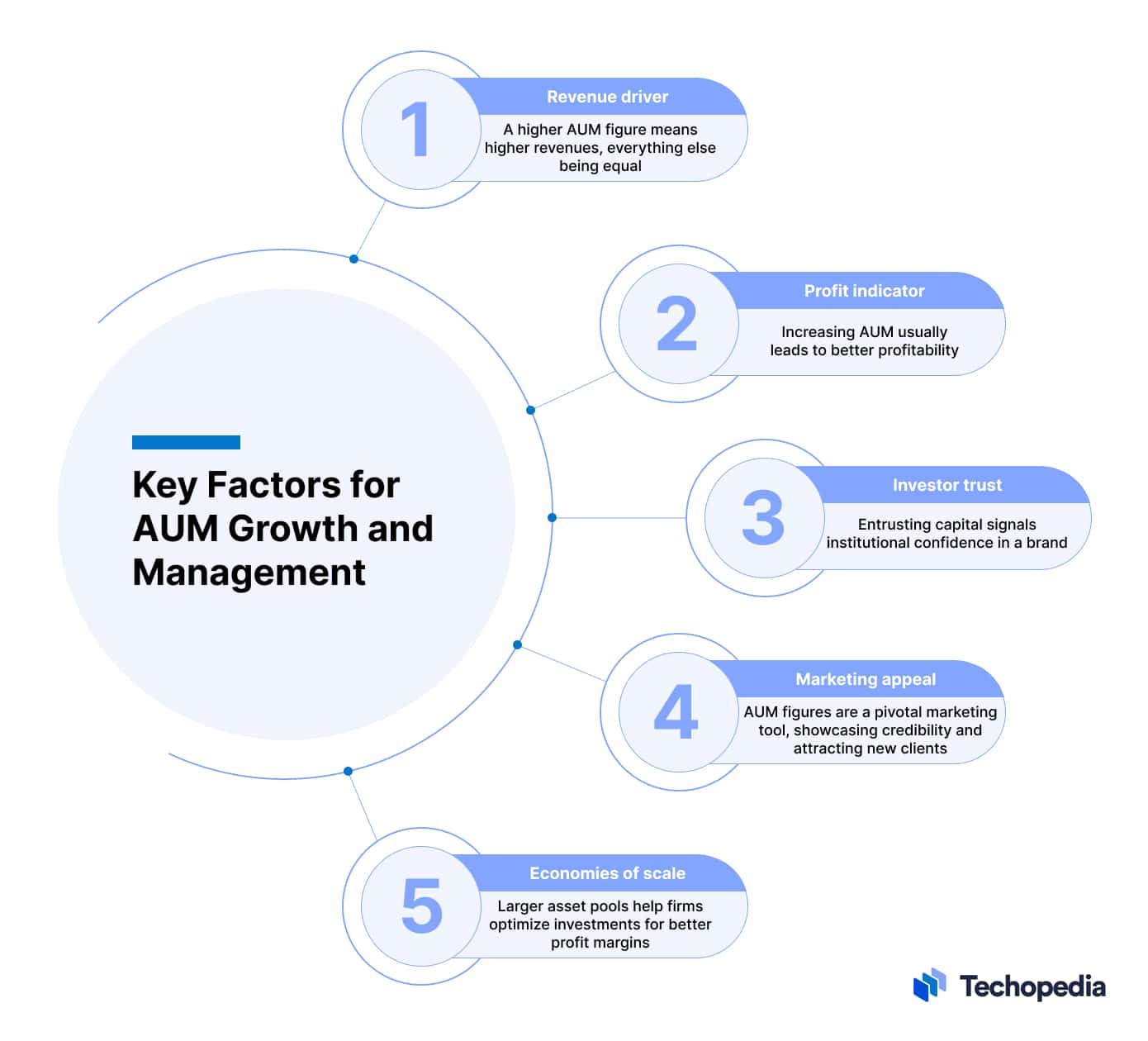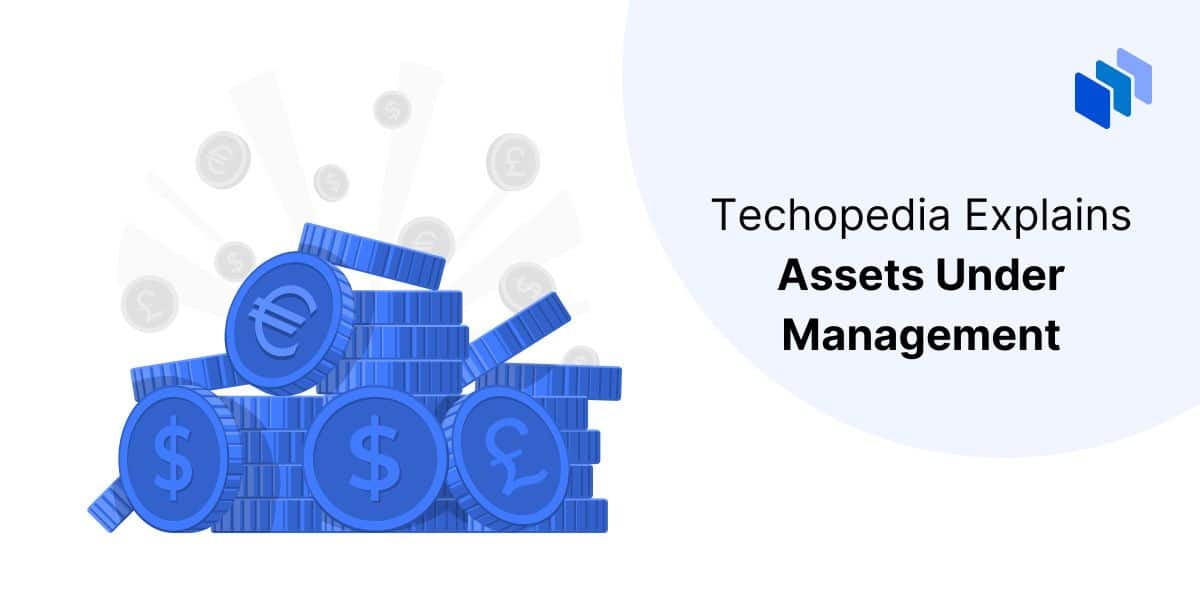What are Assets Under Management (AUM)?
Assets under management (AUM) refers to the total market value of investments or assets that a financial institution manages on behalf of its clients. It is the aggregate amount of capital that investment managers, wealth advisors, and fund companies oversee and invest for their customers.
AUM encompasses the aggregate fair market value of all securities within an asset management firm’s portfolio, including financial assets, real estate, cash, and other asset classes.
As asset values fluctuate daily based on market movements, a firm’s total assets under management change as well. Firms calculate and report AUM periodically as a key metric of their business’s performance.
How Does AUM Change Over Time?
A company’s total AUM amount fluctuates over time for some of the following reasons:
- Market Performance: Asset prices moving up or down changes the total market value of all holdings held in the portfolio. Rising markets increase AUM, while falling markets decrease it.
- Net Inflows/Outflows: Money flowing into or out of investment accounts impacts AUM as balances rise or fall as customers make deposits and withdrawals.
- Dividends & Interest: Any investment income earned that gets reinvested back into the client’s account instead of paid out will increase the firm’s AUM.
- Fees & Expenses: Portfolio management fees, fund expenses, advisor charges, and client account deductions reduce investable capital and, thus, AUM totals.
- Corporate Transactions: Mergers, acquisitions, divestitures, and reorganizations that change the client’s asset ownership impact aggregated AUM, shifting it between firms.
While capital markets drive most AUM fluctuations, asset management firms also increase their asset base by attracting new customers and additional deposits.
Firms aim to consistently grow AUM over time to signal improving market share and revenue-generation potential.
Types of Institutions Tracking Assets Under Management
Many types of institutions track and manage assets under management (AUM), including the following:
The diversity of institutions highlights how AUM provides a consistent metric to gauge the size of their activities and impact across the financial services ecosystem.
Importance of Assets Under Management (AUM)

Revenue Driver: Fees earned for portfolio administration and management are tied directly to the firm’s asset base. A higher AUM figure means higher revenues, everything else being equal.
Profit Indicator: Assuming stable fee structures, an increasing asset pool should be translated into improved profitability over time as costs are spread across an ampler asset base.
Investor Trust: The willingness of investors to entrust their capital to a firm signals institutional confidence in its brand, service quality, stability, and performance.
Marketing Appeal: Total AUM figures are considered a key metric for marketing purposes among institutional, corporate, and high-net-worth investors. Firms can use rapid AUM growth in pitches to attract new customers by tapping on the credibility that this figure conveys.
Economies of Scale: Larger asset pools allow firms to spread infrastructure investments across more capital to improve their profit margins.
While chasing assets can be risky, disciplined AUM gains suggest progress in building capabilities to better serve a wider customer base through long-term investments.
Largest Global Asset Managers by AUM
According to research firm ADV Ratings, below are the top 10 asset managers worldwide by total assets under management as of June 2023:
- BlackRock – $9.09 trillion
- Vanguard Group – $7.6 trillion
- Fidelity Investments – $4.24 trillion
- UBS Group – $3.96 trillion
- State Street Global Advisors – $3.6 trillion
- Morgan Stanley – $3.13 trillion
- JPMorgan Chase – $3.00 trillion
- Goldman Sachs – $2.67 trillion
- Credit Agricole – $2.66 trillion
- Allianz Group – $2.36 trillion
The largest firms are all diversified institutions overseeing multi-asset strategies across markets globally. Their massive asset bases signal investor comfort and underscore operational scale advantages.
AUM Considerations by Fund Type
The ideal amount of assets under management (AUM) varies depending on the fund’s scope and strategy:
- Mutual Funds & Exchange-Traded Funds (ETFs): Higher AUM are a signal of tactical interest for investors. Fund flows may be tracked to determine to which corners of the market investors’ capital is moving. Some funds focusing on specific industries may thrive during expansionary economic cycles, while others could be attractive at times when interest rates are rising.
- Wealth Managers: The appropriate AUM level depends on structural considerations. Funds aim to build a large asset base that allows them to expand and enhance their operational capacity without jeopardizing profitability. They focus on creating economies of scale.
- Hedge Funds: Excessive AUM growth can make it more difficult for managers to identify and execute profitable operations, as large deals are needed to generate positive returns on an ample asset base.
- Private Equity Funds: The nature of the deals made by this type of fund, which often involves taking public companies private through buyouts, requires pooling a large asset base. However, the ideal AUM may be determined by the scope of the fund, as some private equity firms focus on small-cap companies rather than large corporations.
The Bottom Line
Assets under management reflect investors’ confidence in entrusting capital to institutions for investment and custodial services.
While critical for driving profitability, unrestrained AUM growth can undermine a fund’s performance and neutralize the advantages that attracted the inflows at first.
Firms must balance expansion with staying true to their core competencies to maintain trust.






